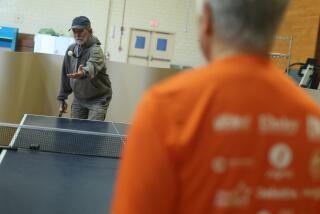Home Visits a First Strike for the Health of Elderly
- Share via
Carl Burnett, 78, sees a doctor when he is really sick. But the semi-retired Van Nuys electrician usually just endures what he figures are the aches and pains of growing older.
His cold feet, for instance. . . . Sometimes, he said, they get so cold that he can’t sleep. But after one doctor ignored his complaint, Burnett said, he never mentioned his cold feet again.
Such stories are common among the elderly. Many suffer discomfort silently, assuming that their problems are inevitable.
But doctors say pain often warns of treatable disease, the early detection of which can prevent expensive stays in the hospital.
“Fifty percent of the people we see are people with major or minor disease that should have been treated,” said John Morely, director of the Veterans Administration’s Geriatric Research Education and Clinical Center. “Most of these people haven’t been seeing a health professional.”
Pilot Program Created
To address the problem, Morely created a pilot health-care project at the VA Hospital in Sepulveda. He based the program on a Danish study that found that people who were given medical tests at home were hospitalized less than people not tested at home.
“The focus of the program is on disease prevention and health promotion,” said Diana Fallbacher, coordinator of the Home Assessment Program for Successful Aging. “We want to keep these people at home as long as possible.”
Retired nurses go to the homes of veterans to administer medical tests that are designed to detect health problems among the elderly.
Patients are told of warning signs and urged to see their doctors. The nurses return every four months.
The program started in August and has screened 32 veterans. One-third were underweight and another third had undetected hearing loss. Other problems that nurses discovered were depression, prostate ailments and glaucoma.
‘Got Him to a Doctor’
One man “swore up and down that he was healthy as a horse,” said Fern Pietruszka, who has conducted most of the initial visits and is training the 15 volunteers. “It turned out he had high cholesterol and high blood pressure. We got him to a doctor so he could get it under control.”
The patients are checked to see if they are susceptible to falls. If so, they are urged to remove slippery throw rugs and install handrails in the showers. To forestall broken hips, the nurses demonstrate exercises.
The nurses also probe the veterans’ mental state.
“The social interventions of this project are just as important as the medical interventions,” Fallbacher said. “Lots of people who are very depressed are put into nursing homes even when they could take care of themselves.”
“Your visit this morning does more for me than anything you can do for me or tell me,” Burnett told a nurse on a follow-up visit a few days ago. “When you go to a doctor, after you are out of there, they don’t remember you at all. If people’s interest is in me, that gives me an incentive to live.”
Visits Useful
Ed Binder, 71, of North Hollywood said the visits are useful even though he gets regular care from private doctors.
“I see a private internist, a private neurologist, a private urologist, a private ophthalmologist, but there is probably not one who can tell you what’s going on in my body outside his specialty,” he said. “My feeling is I need a coordinator. I don’t feel I am four separate systems. They overlap.”
The VA program, paid for by the Disabled American Veterans, could expand nationwide if a planned assessment shows that it is working locally, officials said.
Bruce Nitsche, director of volunteer services for the Disabled American Veterans, said the organization is considering trying the program in St. Louis.
Of course, not every ache means a major illness or even a minor one. For Burnett’s cold feet, doctors recommended warm slippers.
More to Read
Sign up for Essential California
The most important California stories and recommendations in your inbox every morning.
You may occasionally receive promotional content from the Los Angeles Times.













